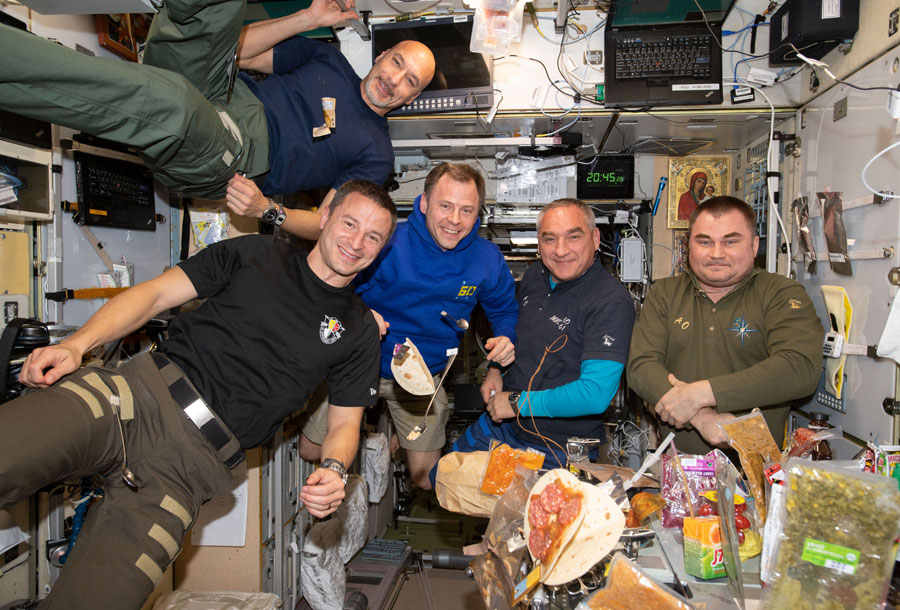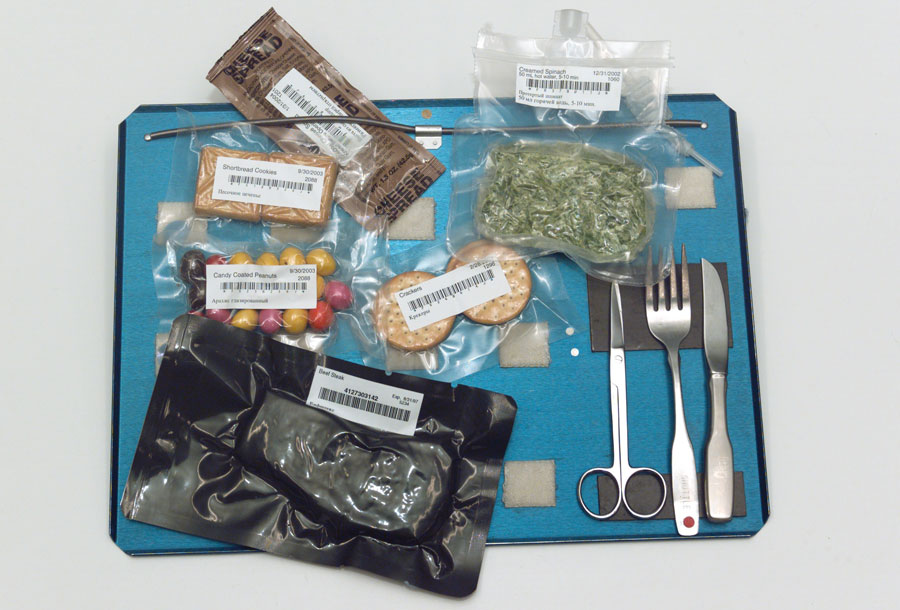
Living and working in a microgravity environment requires culinary ingenuity and creativity. Did you know that bread is not allowed on the International Space Station (ISS)? This is because it produces crumbs that become unmanageable when floating about the space station. The solution: Tortillas! Did you know that your sense of taste can change while in microgravity? A favorite food item on Earth can taste terrible in space. Continue reading to learn more about dining on the ISS.
History of Space Food
In the early days of space flight, Mercury astronauts would consume puree squeezed from tubes and cubes of dry goods. Astronaut John Glenn was the first to eat in space, proving that swallowing and digestion are possible in microgravity. During the Gemini missions, astronauts began consuming freeze-dried food and powdered beverages, which they rehydrated with cold water prior to consumption. The Apollo Program continued to use freeze-dried food and powdered beverages, but with the luxury of hot water if desired. These meals, similar to “Meals, Ready to Eat” (MREs) used by United States armed forces, are still used today, but with improved taste, texture, and options.

Food Preparation Process
Food for NASA’s current astronauts is prepared and packaged at the Space Food Systems Laboratory at Johnson Space Center in Houston, Texas. There, astronauts select the meals they would like for their mission. The lab creates food that is nutritious, ensuring peak health and performance for the crew, and is an important entity for the research and development of meals for long-duration missions of up to five years. Long missions require space foods to have a long shelf-life, meaning it is safe to eat after months or years at “ambient,” or room temperature.
When most people think of space food, they think of “astronaut ice cream,” which is ice cream that has undergone the food preservation process called freeze drying. The first step of the freeze drying process involves freezing fully prepared food at approximately minus 40 degrees Fahrenheit. Next, the food is put into a vacuum chamber and heated so the water content of the food sublimates, or transforms directly from a solid (ice) to a gas (water vapor). The water vapor is sucked out of the vacuum chamber and the process is repeated as many times as necessary to remove nearly all of the food’s water content. This process kills some but not all bacteria, however it does stop bacteria from multiplying and spoiling the food. It essentially leaves the food “frozen” in time.
Additional benefits of freeze-drying are that it drastically reduces the weight of the food item, which means a lighter payload for launch, and it preserves the most nutrients and is easier to rehydrate when compared to other preservation methods.
Other common processes that ensure the longevity of space food are thermostabilization, which exposes cans or pouches to high heat and pressure, and irradiation, which exposes food and packaging to ionizing radiation. Both processes eliminate bacteria that could spoil the food, compromise its shelf-life and make it inconsumable. Astronauts may also eat normal pantry goods in their natural form such as nuts, granola bars, candies, cookies and more, repackaged at the Space Food Systems Laboratory.

How to Eat in Space
Space food commonly comes in plastic packaging or cans. To prevent their food from floating away at meal time, packaging has Velcro patches so it can be attached to a tray or table. Tape, tethers, and magnets are also used to affix food items to surfaces. Additionally, meal time on the ISS requires an additional utensil we typically don’t keep at the dinner table on Earth – Scissors! Scissors are an essential utensil for opening the vacuum sealed bags and retort pouches in which space food is packaged.
One might think that soup is not an option for astronauts, however, foods with higher water content aren’t too much of a problem. Liquid generally stays attached to its package and the utensil used to eat it because of surface tension. However, when drinking rehydrated beverages from a pouch, specially adapted straws are important. The straws have a clasp to prevent liquid from floating out of the straw. This is different than eating soup out of a package, as once the water travels up the straw, it has very little surface to cling to and can float away.
For the same reason that bread is not allowed on the ISS, astronauts cannot season their food with standard ground spices. Pepper tastes much better in your mouth than it does floating into your eyes. The solution: package the seasonings in liquid form.
After the meal is complete, cleaning up is a little different. There’s no soapy sink to wash your hands and utensils. Astronauts will use disinfectant wipes or gently squeeze some water and diluted liquid soap onto their skin, then towel the excess water off. When throwing away their food packaging, it’s important that astronauts consume the entirety of their meals. This is to ensure they get sufficient calories, but also to prevent the extra food from spoiling and creating smelly garbage on the ISS.
Tasting in Space
Most people don’t imagine that gravity has an effect on our sense of taste. Turns out it does, indirectly. When floating in a microgravity environment, the tissues in our bodies become more evenly dispersed instead of being pulled down to our legs and feet. This causes astronauts to experience puffy, or more rounded faces.
When we have a stuffy nose or sinuses, gravity is what causes our nose to run out our nostrils or down the back of our throats. In addition to a puffy face, the absence of gravity leads to congestion, even in perfectly healthy astronauts. If you’ve ever eaten with a head cold, or pinched your nose shut when you had to eat something you didn’t like, you know that smell is an essential to taste. This congestion makes it difficult to smell acutely and causes food to taste different or rather bland. Because of this, astronauts often prefer foods with intense flavors, particularly sweet, salty, bitter, and particularly spicy.
Taste of Space 2021 at Kennedy Space Center Visitor Complex
Luckily for those of us on Earth, we are able to enjoy freshly made food with exciting textures and crunch. This year's Taste of Space: Fall Bites! takes place from October 8 to November 5, 2021. Come treat your taste buds to fun new seasonal flavors at Orbit Cafe and Moon Rock Cafe. These chef-inspired meals can also be enjoyed with a local brew (sold separately). Kids can create their own signature beverage flavors with Pepsi drink machines. For dessert, Milky Way will offer a Pumpkin Caramel Éclair. Beer lovers will want to stop by Planet Play Lounge to enjoy local seasonal brews from the Space Coast!
Guests may also partake in Taste of Space: A Culinary Journey on November 5, 2021. Join veteran NASA astronauts as you begin in the Rocket Garden with unique appetizers, then walk to Rocket Garden Cafe for award-winning clam chowder and fresh salads. The surf n’ turf “main course” will be served in Dine With An Astronaut. End the evening underneath space shuttle Atlantis with a Marstini shake off, some sweet treats, music and entertainment. Each course will include a sample size wine or beer pairing.




